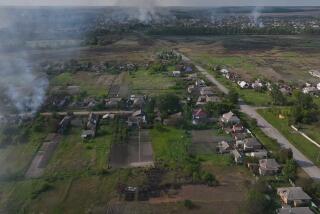Nuclear Pollution Plagues Former Soviet Union : Environment: A map marking non-military explosions shows scope of ‘national disaster.’
- Share via
MOSCOW — On the wall of his new Kremlin office, Alexei Yablokov, Russia’s preeminent environmentalist, plans to hang a onetime secret map of the former Soviet Union.
The map contains 126 black dots. There’s one for each non-military nuclear explosion set off during the 1960s, ‘70s and ‘80s, decades of Soviet power, by engineers and their allies in Moscow bureaucracies intent on taming a continent to build a superpower.
“The monster of pollution takes many forms,” says Yablokov, Russian President Boris N. Yeltsin’s top adviser on environmental policy and public health. “But the most serious is radioactive contamination, especially from these so-called peaceful bombs.”
Yablokov displays a map of Moscow with more than 200 red dots--documented nuclear “hot spots” caused by buried radioactive waste or leaks over the years from secret military and scientific research centers in the Russian capital of 9 million people.
“The information on these maps was absolutely top-secret until a few months ago,” says Yablokov, a marine biologist and longtime environmental lobbyist who rose to prominence under former Soviet President Mikhail S. Gorbachev as head of a legislative committee on environmental protection.
He says it is too early to know exactly how much fallout spilled from the “peaceful” explosions, or their effects on public health. But he calls nuclear contamination a “national disaster” that is a major cause of declining life expectancy across the former Soviet empire.
Yablokov’s anxiety is shared by Russia’s new environmental minister, Viktor Danilov-Daniliyan, who says that nuclear waste and nuclear accidents have made large parts of Russia uninhabitable.
“Big chunks of the republic are so poisoned they will not be suitable for human settlement for a very, very long time. We are talking decades,” he says.
Danilov-Daniliyan, an economist, confirms that Russians are still being uprooted for resettlement in safe areas as a result of decades of nuclear mishaps and indiscriminate dumping of nuclear waste.
Fallout from the 1986 Chernobyl atomic power plant explosion in Ukraine has poisoned regions around the southern Russian cities of Bryansk, Kaluga and Tula, places that were considered safe until last year, he says.
Authorities have moved an unknown number of farmers from the area around these “hot-spot” cities north of Chernobyl and from neighboring Belarus, says Danilov-Daniliyan.
Medical studies from the contaminated places consistently blame radiation in the food chain for increased rates of thyroid cancer and birth defects in children.
Ukrainian authorities say that by the end of this year they will close the two Chernobyl reactors that are still generating electricity.
The average life expectancy in Russia has dropped to 69.3 years--the lowest in Europe--after peaking in 1986 at 70.1. Western scientists generally support the contentions of environmentalists like Yablokov that pollution, especially nuclear contamination, is at least partly to blame.
Underground nuclear bombs were detonated to increase pressure on oil and gas fields in Siberia, to create huge subterranean caverns to store toxic wastes and to help geophysicists conduct seismic tests.
More atomic bombs were detonated above ground to help construct dams and move massive amounts of earth for open-pit coal and diamond mines in the Yakut-Sakha region of Siberia, says Yablokov. At least 12 blasts have been confirmed there.
Yablokov has verified 26 nuclear explosions in the Volga River basin, which winds through a broad region of western Russia, and at least 80 explosions in the rest of the giant Russian Republic.
In another case, documented by a Yablokov protege, biologist Maria Cherkasova of the private Socio-Ecological Union, at least seven nuclear bombs were set off in salt domes near the Caspian Sea. This was done to create underground reservoirs for crude oil similar to the naturally created caverns of the American strategic petroleum reserve in Louisiana.
“Now the salt is on the move toward the surface,” says Cherkasova, “and so is the nuclear contamination.”
“We have heard numbers in the low 30s about non-military nuclear explosions in the Soviet Union,” says an official of the U.S. Environmental Protection Agency in Washington, D.C., interviewed on the condition his name not be published. “But no one has come up with numbers and specifics like this.”
Danilov-Daniliyan and Yablokov also are concerned about widespread nuclear contamination of the Chelyabinsk region in western Siberia, an area one Western scientist has called “the most polluted place on Earth.”
Thomas B. Cochran, senior physicist at the Natural Resources Defense Council in Washington, who has visited a nuclear waste dumping site near Chelyabinsk, adds verification.
“Nowhere else on Earth,” he says, “can you stand and get a lethal dose of radiation in an hour.”
More to Read
Sign up for Essential California
The most important California stories and recommendations in your inbox every morning.
You may occasionally receive promotional content from the Los Angeles Times.













